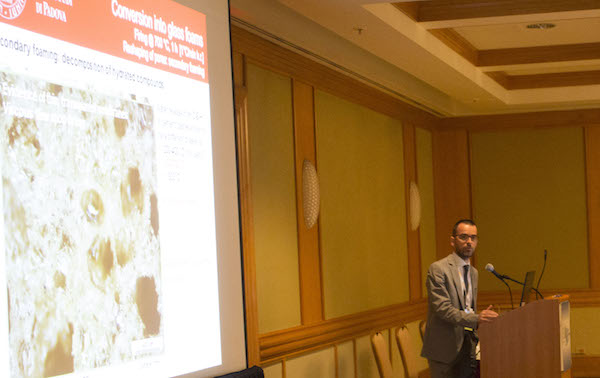
[Image above] Exchanging ideas in presentations comprises the heart of a technical conference. Here Professor Enrico Bernardo of the University of Padova, Italy, shares results about biomaterials. Credit: ACerS
Student report by Yiyu Li, Alfred University
Processing is critical and crucial for advanced materials and sustainable development. A lot of excellent studies on material processing and characterization were included in the G1 session, Powder Processing Innovation and Technologies for Advanced Materials and Sustainable Development, during the 9th International Conference on High Temperature Ceramic Matrix Composites and Global Forum on Advanced Materials and Technologies for Sustainable Development 2016, which is being held in Toronto, Canada.
Professor K. Kobayashi from NIMS in Japan reported some great results on the development of wet-chemical process for lanthanum germanate oxyapatite. The synthesis of lanthanum germanate oxyapatite is quite difficult because of the high volatility and low meting point of germanium dioxide—both of which are usually applied as raw materials. He revealed that they adopt both sol-gel and co-precipitation methods at lower expense to successfully prepare this material with single phase. It is also very exciting that the electrical conductivity of as-sintered ceramics from these powders is comparable to the one of yttria-stabilized zirconia (YSZ).
Inspired by nature, Professor D. Zhang‘s group from Shanghai Jiaotong University in China developed various amazing composite materials with excellent mechanical and electrical properties. They got the brilliant idea from the regular ‘brick-and-mortar’ structure of natural nacre and applied this structure for fabrication of composite materials to obtain improved properties. The research correlates our daily life to materials processing through discovering the fundamental nature of objects, and it provides infinite possibilities for advanced materials processing by looking to nature inspiration. Additionally, Professor W. Tuan from National Taiwan University and his team got some novel concepts derived from fish scale and used them to design an alternative toughening agent. He suggested the toughness of ceramic could be enhanced by adding fish scale due to its hierarchical complexity.
Dr. N. Isu from LIXIL Corp. in Japan presented some interesting results on his research that focuses on energy-saving housing materials by using nanoporous ceramics structure. By adopting mesoporous ceramic tiles and vacuum insulation panels, Isu and his team successfully controlled indoor humidity autonomously and reduced the emission of CO2, decreasing electrical power consumption.
I have learned a lot from this conference. To be a competent scientist, not only do I need to get good experimental results, but also I have to think of ways to create innovative materials with better properties without adding to the pollution of our planet or wasting the limited resources to meet the increasing demands of the mankind. The researchers and professors in the Powder Processing Innovation and Technologies for Advanced Materials and Sustainable Development session set outstanding examples for how to combine scientific research work with social responsibility. In the future, I will definitely work hard to develop innovative and sustainable routes for materials processing.
Author
Yiyu Li
Spotlight Categories
- Meeting Highlights
Related Posts
Volunteer spotlight: Hyunjun Kim
December 18, 2025
ACerS GOMD History – A Look Back in Time
December 10, 2025


